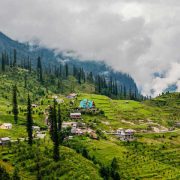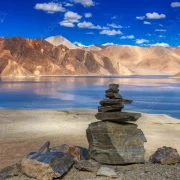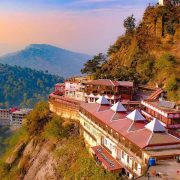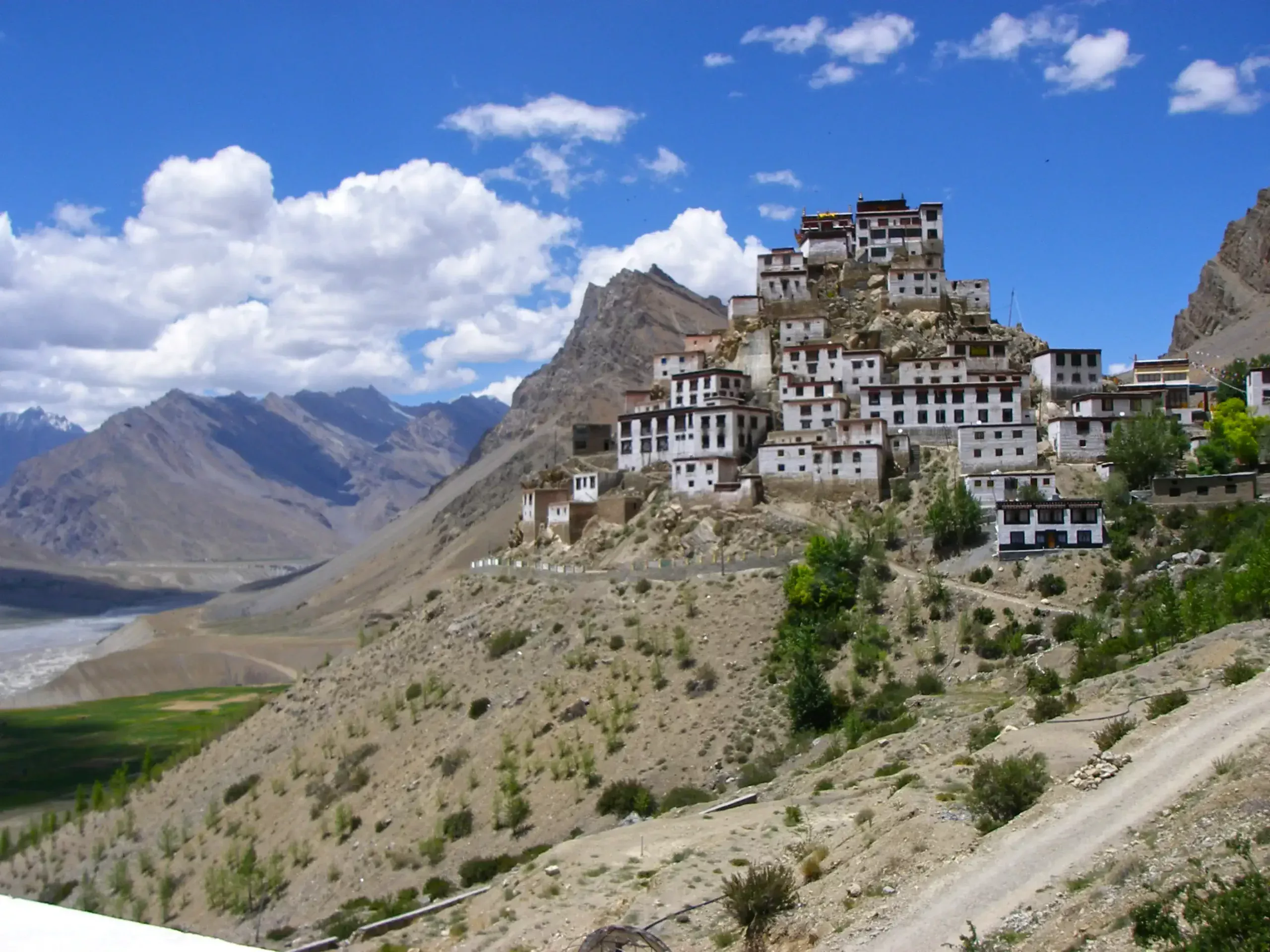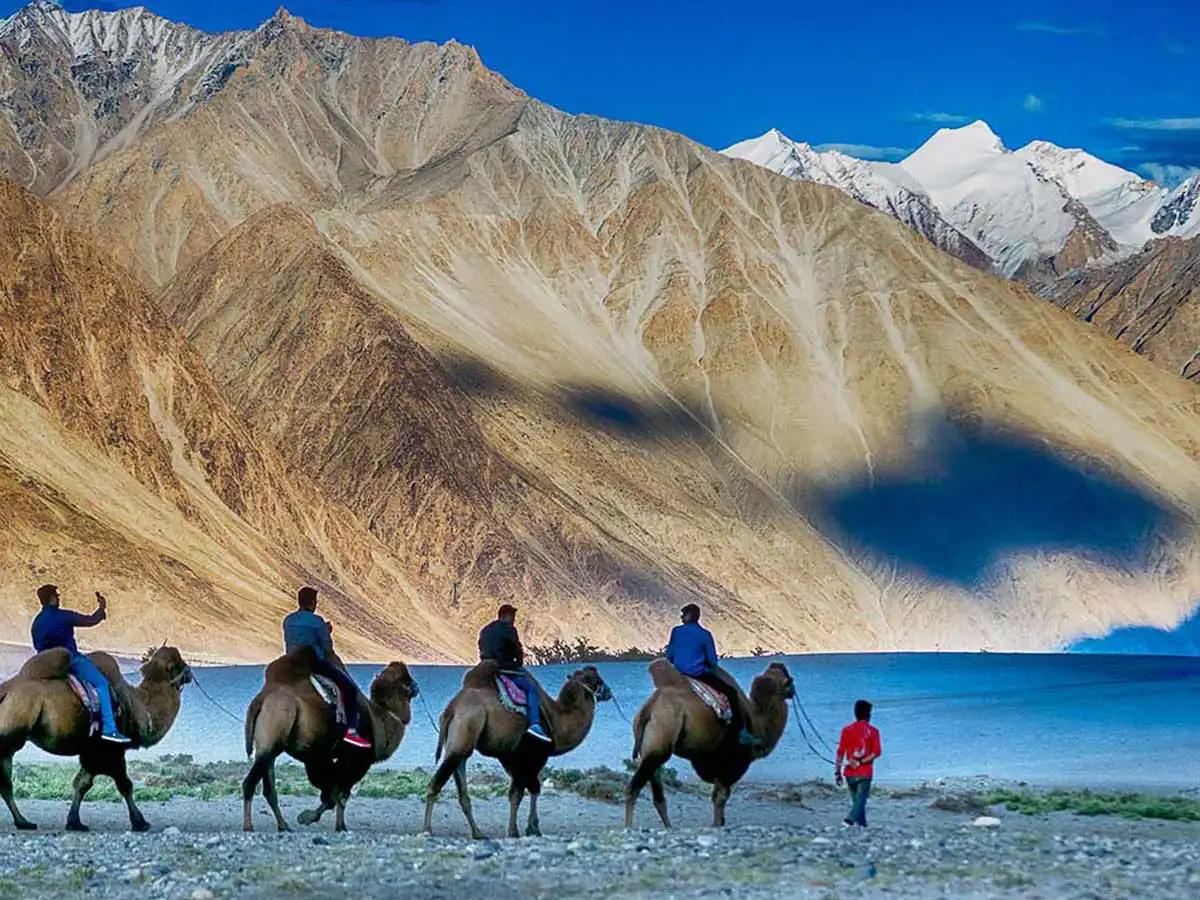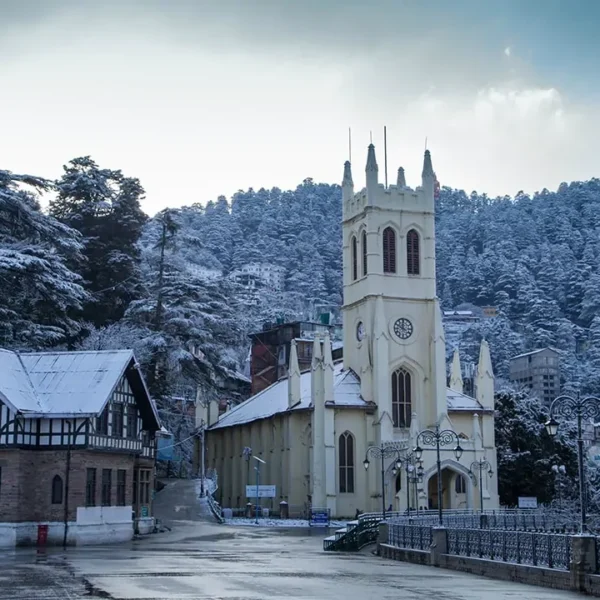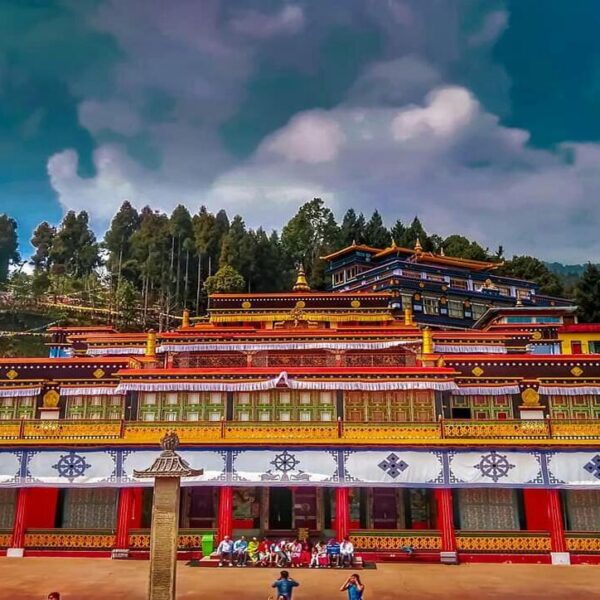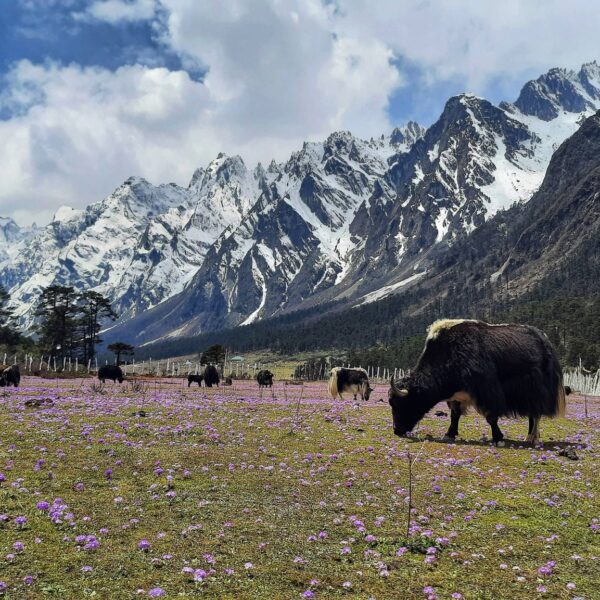5 Places to explore in Chamba Himachal Pradesh
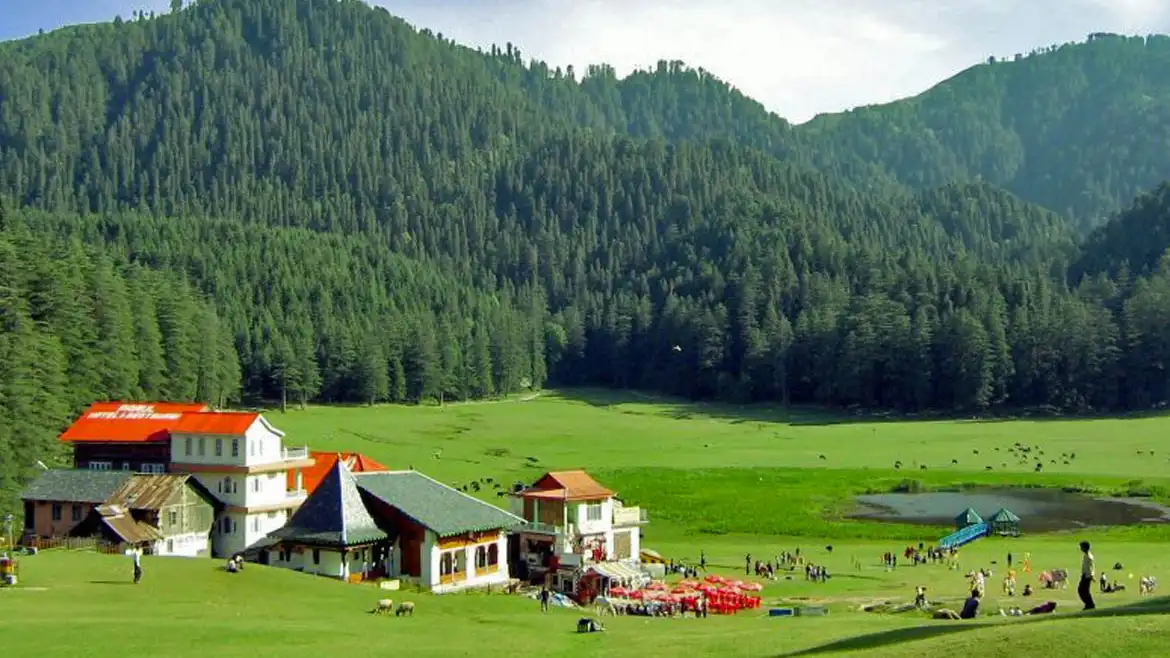
5 Places to explore in Chamba Himachal Pradesh
Traveling and Trekking in Chamba Region
Nestling on the right bank of river Ravi, at the scenic spot where the smaller Sal river meets the larger one, the sprawling town hill of Chamba was founded on terraced flats over a thousand years ago. It was Raja Sahil Varman from the royal house of Bharmaur who shifted his capital to Camba in 920 A.D. on the advice of his daughter Champavati.
Bound between high ranging mountains, Chamba (altitude 996 m) over generations developed a highly skilled home grown architectural style, a ‘Pahari’ art from ad a niche handicraft industry. Strolling through the town’s old lane, Chamba still preserves much of its medieval past in temples, palaces and mny other mountains.
Stone built, capped with wood and slate roofing, the shikara style Lakshmi Narayan Temple complex, consisting of 6 temples is a landmark in the historical town. The main temple, dedicated to Lord Vishnu, was built by Raja Sahil Varman.
The Hari Temple, near the Chaugan, dates back to the 11th century and is known for the four armed bronze statue of Lord Vishnu as Chaturmurthi, a masterpiece in metal craft. Overlooking the town, the temple of Goddess Chamunda Devi has got fine wood carving adorning its exterior and interiors.
The Akhannd Chandi Palace was the Royal residence from 1747 to 1765 and has now been covered into a college.
Popular Places to check out near Chamba
Saho: Outside of Chamba, 18 km away, on the bank of Sal river is Saho, a village. At this village the Chandarshekhar Temple is over 1100 year old. A naturally formed Shiva Ligam, covered with copper is placed here and worshiped.
The villager claim to be descendants of Lord Shiva and believe that is from Saho that the Lord made the journey to Manimahesh Kailash Peak in Bharmaur to settle there. In September an annual fair is held at the temple where the “Bhasmasur Dance” is of special attraction.
Chamba Jot: High over the valley, overlooking the town, the hilltop ‘Jot’ is about 3km from Chamba. For its commanding view, the Jot attracts a lot of visitors. In winter it receives heavy snow that can pile up to 7 feet. The scenic meadows of Khajjiar, 20 km away, is an easy grade trek. In summer regular buses and taxis from Chamba ply to Jot.
Katasna Devi Temple: Overlooking Chamba Valley, this Devi temple is near Bairu Sihul hydroelectric project and is a pilgrim attraction as well as picnic site. It is 30 km from Chamba.
Jhumar: In the vicinity of thick alpine forestlands, the apple orchard country of Jhumar has a special rural charm. It is only 10 km from Chamba.
Off Beat Tracks In Chamba
Salooni: Spread out along a ridge between the towering Pir Panjal and Dhauladhar ranges, Salooni, overlooking the Bhandal Valle is a very scenic place where many film director have shot romantic sequences. The nearby Gamgul Siabehi Wildlife Sanctuary Conserve rich Himalayan flora and fauna which include musk deer, barking deer, monal pheasant and the snow leopard. Salooni is 56 km from Chamba and the game reserve is 20 km from Salooni.
Bhandal: The Bhandal valley opens up at Salooni and through Langhera Links up with Kishtwar region of Jammu. The valley is rich in flora and fauna and is a popular trekking area, with there being a range of walking options available in and around Bhandal.
Bhalei Mata Temple: The Revered deity bat Bhalei Mata temple as Bhadra Kali, a mother goddess, is worshipped aa destroyer of evil. The original Temple as built by Raja Pratap Singh Varman, a contemporary of Akbar, the Mughal in 16th century. For the spring and autumn navratras, many pilgrim make their way to pay obeisance at the Bhalei Mata Temple and the place wear a decorative look for the religious festivities.
Top Tourist Destinations in Chamba
Dalhousie
Shielded on the northern side by a tattered fringe of lofty Dhauladhar peaks, Dalhousie is a coo hill retreat with a bygone colonial charm. A veneer of Tibetan culture has added an exotic touch to this serene destination. Spread out over the five hills of Kathlog, Potreyn, Terah, Bakrota, the town was founded in the 1850 by Lord Dalhousie, a young Governor General of India who was only 36 when he assume office. The tow’s two market areas, the Subhash Chowk and Gandhi Chowk are linked by oak, cedar and rhododendron shaded lanes of Thandi Sarak and Garam Sarak with the latter getting more sunshine.
- St Jhon’s church at Gandhi chowk being the oldest church of Dalhousie. Elaborate wood work dark interior and remarkable stained glass wok make St Francis Church at subhash chowk, built in 1894 a pride of town Attracted to the healing charm of the hill station, freedom fighter Subhash Chandra Bose stayed for many months at Dalhousie in 1937. The spring fed Subhash Baoli and Subhash chowk are named after him. For Shopping the township has well stocked handicraft shops. One can buy woollen Himachali Shawls, decorative chamba rumals, traditional jewellery or Tibetan handicrafts at the Tibetan handicraft Center.
- At a walking distance from the town centre are the seven sprigs of Satdhara that are known to have some medicinal properties. Panjpulla is a pretty spot where 5 bridges have been constructed under which water from natural sources flows. A 5 km popular walking circuit through Bakrota has splendid mountain views.
- Dainkund is a 2745 meter high hill, 10 km from the town centre that offers dee panormi9c views of the mountains, verdant valleys and the snaking Beas and Ravi river threading their silvery passage down to the palins.
Khajjiar
Often compared with Swiss mountain meadows, Khajjiar is a wide grassy clearing around a pond in a thick cedar forest. This scenic spot, only 23 k from Dalhousie and 26 km from Chamba, is more than a picnic spot.
Kalatope
The Higher hill range of Kajjiar forms the Kalatope Wildlife Sanctuary, an ideal trekking country with sheltered wildlife, which include Himalayan Black Bear, Ghoral Deer, Monal pheasant and other. Summers are pleasant but winters can pound Kalatope with heavy snow that at times can pile to a heap of over 5 feet. At Bara Pathar, in the vicinity of the sanctuary is a small temple of Bhulwani Mata in the village of Ahla. A fair celebrated in July venerates the goddess.
Chamera Lake
Back waters of Chamera Lake, a reservoir created by damming of river Ravi, has turned into a scenic lake that has became a popular recreational and water sports center. A water sport sub- center hare regularly conducts courses in swimming, sailing, water skiing, kayaking and other sporting disciplines. A lakeside resort has come up at Taleru where boating facilities are available. The man made lake is only 25 kms from Dalhousie and 40 kms from Chamba.
Bharmour
Bharmaur on the bank of Budhal river was the original capital of the Chamba royal family for about 400 years before Raja Sahil Varman moved it to Chamba in 920 A.D. Enclosed between the Dhauladhar and Pir Panjal ranges, Bharmaur has abundance of alpine pastures and is home to the nobel Gaddi Tribe. As the earlier power center of the valley, Bharmour was known for its grandiose; the remains and monuments, best exemplified in the Chaurasi Temple complex, exhibit the historical heritage of the town ship.
Buit in the 7th century and dedicated to Lord Shiva as Manimahesh, a shikara style temple is the main shrine of the Chaurasi Temple complex. A life size bull idol of Nand, in polished brass, guards the entrance. Spread over the ground are 84 other temples, giving the place its name of Chaurasi, meaning 84 shrines in the local dialect. The Lakshna Devi temple with an idol of a four armed goddess Durga as a slayer of Mahisasura, the demon, is believed to the oldest temple here. Other important temples at the compound are that of Narsingh, Dharmeshvar Mahadev and Ganpati Ganesh. Overlooking Bharmaur 4 kms for the town, on a hill is the temple of Bharmani Mata, considered as the guardian goddess of the valley. All pilgrim who go for the annual Manimahesh pilgrimage, only do so after starting by taking a holy dip in a pool at this temple to seek the Devi’s blessing for a safe journey into the high mountains. There are many trekking trails of ease to stiff grades in and around Bharmaur. Many adventure seekers frm the country and foreigners take to summer camping an trekking in these valley.
Off Beat Tracks in Bharmaur region
Manimahesh Yatra: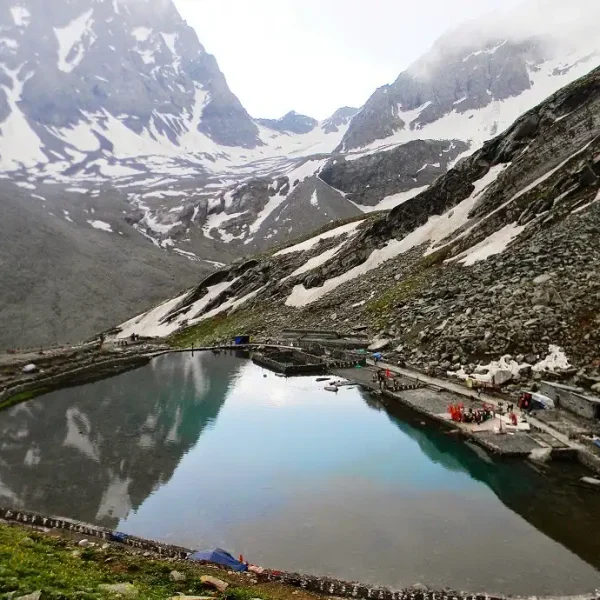
The Towering Manimahesh Kailash peak at 5656 meters, reflected in the serene healing waters of a turquoise lake evokes a spontaneous prayer in the pilgrim and trekkers who make the effort to get there. Manimahesh lake is an important pilgrimage place. Each year thousands converge for the Manimahesh Yatra in August – September to pay obeisance to lord Shiva. Singing devotional songs, pilgrims wind their way up an arduous track to bathe in the icy water of the lake and worship at a small lakeside temple. Belief holds that Lord Shiva reside on the holy peak. Manimahesh is 34 km from Bharmaur.
Kugti Pass (Trekking route into Lahaul Valley):
An arduous 5 day trek over the 5040 metr high Kugti pass that crosses over the Pir Panjal range to Jobrung in Pattan Valley on the Udaipur Keylong road in Lahaul is a challenging adventure. A motorable road from Bharmaur extend into the valley for another 19 kms throush Hadsar to Dhanol, the base camp for the trekking route. Surrounded by the thick conifer forest, just below the pass, Kugti is the latest inhabited village before a steep ascent has to be negotiated to get to the pass. The trek is a difficult one and one need to preserve well. Do take time to acclimatize to high altitude trekking for undertaking this route. Only the physically fit and seasoned trekkers should attempt it.
Chhatrari:
This hamlet high in the valley with its well preserved hill style temple of Shakti Devi is associated with Meru Varman, the 7th century founder of the Bharmaur royal house. The temple has a well preserved idol that has the date 680 A.D. inscribed on it which was the time when Meru Varman laid the foundation of the Bharmaur Kingdom. The stone and wood structure, capped with a slate roof, is considered to be the last temple built by Gugga, a master artisan who worked for Bharmaur royal family. In fact the temple has an idol of Gugga himself. Decorated wood facades on the temple are works of intricate craftsmanship.
In September at the time of the annual Manimahesh Yatra, water from the holy lake is brought to the temple to bathe the idols. A masked dance is performed on the occasion by Gaddi Tribesman, where one dancer, who portrays a good doer, enacs to be seen triumphing over three others who represents evil forces. Chhatrari is 40km from Chamba on way to Bharmaur.
Churah Valley :
Less Travelled and lesser known, the rural charm of churah valley of chamba is a circuit in itself and a real treasure for those on the look out for offbeat destinations. On the crossroads of Himachal Pradesh and the state of Jammu and Kashmir, it is one of the relatively least untouched Himalayan habitats. Hidden gems of Churah valley include Bhandal kihar, Thalii Bhatkar, Bhukku Dhar, Jasorgarh, Dudar Dhar, Baira, Salooni Kilod, Himgiri Banter, and devi Kothi.
The 27 km route from Tissa to Bairagarh is a tough drive. Trella, a small station enroute, till recent times used to be the only market for residents of Pangi Valley. The road ascends to Satrundi and the panoramic landscape from here is one of being in the company of towering and grand Pir Panjal peaks around. The high point on the route is Sach Pass at 4428 m before it descends into Chenab valley to meet the Tandi Kishtwar road at killer. Normally this stretch of the road is snowbound from late Nvember to June/July.
Pangi Valley:
THE land across Sach Pass is Pangi, a valley full of grandeur and tribal majesty. The native Pangwals and Bhotis are a robust hardworking and handsome people who keep the valley unique culture alive in folk songs, music and tribal dance. DSpread over an area of about 1600sq km of steep, rocky and tough Himalayan terrain, Pangi is an offbeat and challenging tourist destination. Consisting of Saichu, Hudan Bhatori and Sural Bhatori valleys, the 55 villages that hold a population of about 18000 people have been opened up for travel as roads have penetrated the area. Much of the remote area still has to be covered on foot only.
Killar
27 km from Sach Pass is the sub devisional headquarter of the village and there are a number of exiting and challenging trek routes. Those headed to Sach pass and beyond should be travelling in a sturdy off roading vehicle be equipped with good quality travelling gear have spare tyres, food rations, exrta gallons of petrol / diesel and need to carry emergency medicines. Kilar is 137 kms from Chamba
Popular Treks in Chamba Himachal Pradesh:
Treks of 5-8 days duration, viable from June to October include:
- Chamba to lake Manimahesh 4170m a 7 day Yatra.
- Chamba to Killar in the Pangi Valley over the Sach pass and onwards to Kishtwar in Jammu & KashmirChamba is also the base for delight one or two days trek to places like Khajjiar, Jhumar and Kandi- Bassu.
- Bharmaur to Trilokinath/Udaipur in Lahaul over the Kalicho Pass 4803m.
- Bharmaur to Udaipur over the Chobia Pass 4966m.
- Bharmaur to Udaipur/Manali over the Kugti Pass 5040m.
- BHarmaur to Lake Manimahesh 4170
Recent Posts
Kullu Manali Tourism to Resume by October 1, 2023 after Massive Flood and Landslide in Himachal Pradesh
Top 5 Reasons to visit Leh Ladakh in 2023
The Alternate Himachal Pradesh
All Categories
Last Minute Deals
- Quality4
- Location4.5
- Amenities3.5
- Services4.5
- Price4.5
Amarnath Yatra Package
- Quality4
- Location4.5
- Amenities3.5
- Services4.5
- Price4.5
Shimla Manali Tour From Chandigarh
- Quality4
- Location4.5
- Amenities3.5
- Services4.5
- Price4.5
Sikkim Darjeeling Gangtok Lachung Package
- Quality4
- Location4.5
- Amenities3.5
- Services4.5
- Price4.5
North Sikkim Tour Package
Contact Us
At Antelope Tour and Travel, we are always ready to provide you with any information related to trekking and touring to various remote areas in Himachal Pradesh and Ladakh region. Feel free to reach us.


